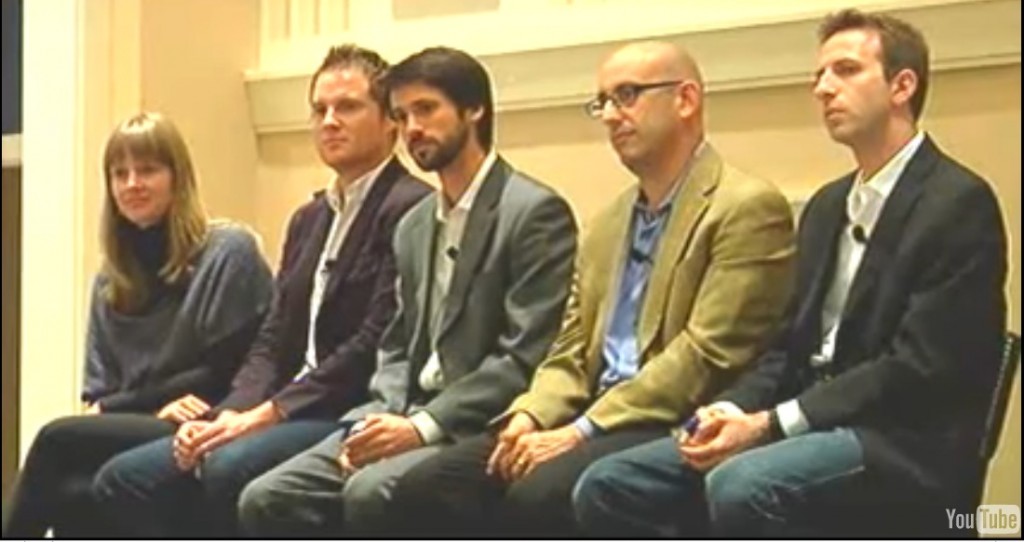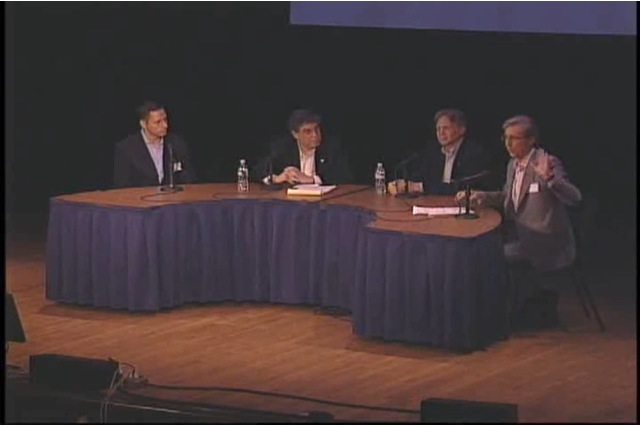VOTE for MiniTrends Panel for SXSW Eco 2014 by May 16 – “Creating a Profitable & Purpose-Driven Business”
May 11, 2014
PLEASE take a moment to VOTE for MiniTrend’s panel submission for SXSW Eco Conference titled “Creating a Profitable and Purpose-Driven Business” at http://panelpicker.sxsw.com/vote/29857 by May 16.
The panel includes Carrie Vanston, VP, Communications, MiniTrends/TFI; Jeffrey Fry, Chief Executive, The Profit Prophet; Andre Angel, Founder/CEO, TangoTab; and Joy Miller, Marketing and Outreach Coordinator, City of Austin Small Business Development Program..Short videos of each panelist can be found at http://vimeopro.com/
A third of the decision is directly from votes! You do have to sign in, but it does not take long to vote. Please go to http://panelpicker.sxsw.com/vote/29857 and VOTE NOW.
Thank you so much for supporting the creation and growth of purpose-based businesses and making a difference in the world!
InnoTech Conference Teeming With Emerging Trends
October 25, 2011

Sean Lowry, Exe. Dir., Innotech and Carrie Vanston, Co-Author, MINITRENDS at Innotech Conference, Photo by Sloan Foster
I’ve attended the InnoTech Conference and Expo and its associated eMarketing Summit for several years now and always learn a lot. This year I wanted to pass on some comments from experts that I heard yesterday relating to emerging trends that are becoming more and more important:
Sean Lowry, of the very successful InnoTech series, always does a great job of making sure everything runs smoothly. I was even able to steal him for a minute to ask what emerging trends he saw coming. He told me, “I see continued convergence of all the different technologies we are seeing here today. Development of mobile applications and host applications in the cloud are particularly important. There is so much video activity and a lot of it is being hosted in the cloud now.”
I asked Giovanni Galluci, social media expert and Dallas photographer what he thinks the next trend in social media is going to be. He said, “Getting over it. Everyone is burnt out with all the hype and now people are looking for more meaning in social media. Twitter is ridiculous. Those who do marketing are beginning to realize it. Online social media is becoming part of the umbrella of marketing, which is where it belongs. Social media is becoming more commodatized—as in more of a commodity.”
He gave several great hints about Facebook including that Facebook ads are the best way to grow a fan base; Facebook is the 2nd largest search engine, so take advantage of it (including using pictures with metatags, main key words in description, etc.); and put Facebook info on all your printed matter including cards and bills.
I chatted with William Leake, CEO of Apogee Search Marketing, and his take was that “More and more advertising presence is going to be driven by physical location. If you don’t have a physical location strategy, you are going to lose.”
Craig Wax, CEO of Invodo and a video expert, had a lot to say about the future of video marketing. According to Craig, “In the future, no one is going to stand in line anymore. Offline and online is no longer relevant. This is already starting to happen and it is going to become ubiquous.” He added that “QR readers are going to be incorporated into devices and the present obstacles to their use will be chipped away.” (On a side note, Craig was most recently the Senior Vice President and General Manager at Match.com. That had to be an interesting job!)
According to Pat Scherer, Web and Mobile Deployment Manager at The Detail Person, “Mobile space is going to be huge. With the explosion of devices, I think it’s going to make a huge impact on the retail industry. Not only for payments, but for creating local-based experiences utilizing mobile social media. I anticipate this leveling the playing field with e-commerce.”
Finally, I got to chat briefly with siblings Kevin Olsen and Kerri Olsen, Co-Founders of the Austin Grand Prix. Having Formula 1 in Austin exciting!
Cheers,
Carrie Vanston
Media/Marketing Director, Technology Futures, Inc.
Co-Author, MINITRENDS: How Innovators & Entrepreneurs Discover & Profit From Business & Technology Trends
Google, Yahoo Struggle with Technology Innovation
March 30, 2011
 Google is taking a slice from Apple’s strategy, bringing back company co-founder Larry Page to ignite innovation at Google, where the stock has flatlined for the past year. Page is scheduled to take over next week as CEO from Eric Schmidt, who is reportedly under consideration for the Secretary of Commerce position in U.S. President Barack Obama’s cabinet.
Google is taking a slice from Apple’s strategy, bringing back company co-founder Larry Page to ignite innovation at Google, where the stock has flatlined for the past year. Page is scheduled to take over next week as CEO from Eric Schmidt, who is reportedly under consideration for the Secretary of Commerce position in U.S. President Barack Obama’s cabinet.
It’s often difficult for mature companies to innovate the way startups do. For one thing, they lack the financial compulsion that drives entrepreneurs to market or die. Look at how News Corp. has shouldered losses at MySpace while Facebook restlessly innovates, or what happened to AOL after the merger with Time Warner, or what might happen to The Huffington Post now that it has been acquired by AOL. Google can afford to simply hold onto a company such as YouTube without the pace of self-improvement often seen in startups.
Amir Efrati, who covers the Internet for The Wall Street Journal, has been stirring things up in Silicon Valley this past week with fascinating reports on attempts by Google and Yahoo to stay innovative. In an article last Saturday, Efrati used unnamed sources to speculate that Larry Page is being called back to “speed up what [Page] says has been sluggish decision-making at Google’s top levels.”
One of Page’s new edicts, according to The Wall Street Journal, is face-to-face bullpen sessions:
… [E]very afternoon, [Page] and the company’s executive officers sit and work on small couches outside a boardroom in Building 43 at Google’s headquarters.
That might have worked when Page left the company in 2001, with 200 employees. Whether it will work 10 years later, with over 100 times as many people on the payroll, remains to be seen.
The difficulty of fostering innovation in mature companies is one of the main drivers behind the Minitrends project at Technology Futures, Inc., the Austin, Texas, technology forecasting firm and publisher of the book, MINITRENDS, and this blog. The authors devote a significant portion of the book to fostering innovation in large corporations:
Fewer than 30 percent of the companies listed on the Fortune 100 twenty-five years ago are still on the list today. Often the primary reason for the demise of such companies has been a failure to recognize and react to changing trends.
One of the ways that companies innovate is through acquisition rather than invention. Efrati generated a second round of buzz this week when he quoted Yahoo’s director of development, Steven Mitzenmacher, on The Wall Street Journal‘s Digits blog as saying Google’s investment in YouTube was “crazy.” It’s an odd comment, given YouTube’s burgeoning revenues and the fact that Yahoo is embarking on a buying binge to remain relevant.
Savvy institutional investing reporter, Riley McDermid, follows the fallout from Page’s return to Google in an insightful article at VentureBeat. Always one step ahead of the competition, McDermid managed to write about The Wall Street Journal‘s article a day before the article appeared. It’s hard to keep up with futurists!
So where do large corporations find the stimulation they need to stay at the forefront of technology trends? Among the resources mentioned in MINITRENDS are innovation competitions and working papers. Among the best examples of where to find both is the National Collegiate Inventors and Innovators Alliance (NCIIA), which held its version of “March Madness” — an innovation competition — in Washington, D.C., last Saturday.
The NCIIA competition is sponsored by companies that are working to stay competitive and rewarding innovation in education. The NCIIA has already published all the conference papers online, for free; they contain a treasure-trove of ideas for mature companies looking for a little stimulation or entrepreneurs looking for adventure.
If you prefer to watch rather than read, we recommend you screen the videos submitted to the NCIIA’s “Open Mind” Awards and nicely catalogued by David Orsman at Inventors Digest. It’s by doing research like this that you are likely to find the Larry Pages and Steve Jobs of tomorrow, who will set the technology trends that others follow.
STEVE O’KEEFE
News Editor, Minitrends Blog
Source: “Obama Nears Appointment Of Eric Schmidt As Commerce Secretary,” BusinessInsider, March 18, 2011
Source: “At Google, Page Aims to Clear Red Tape,” The Wall Street Journal,” March 26, 2011
Source: “Larry Page already cracking the whip at Google, a week before he takes the reins,” VentureBeat, March 25, 2011
Source: “Yahoo Executive Talks Acquisitions, Slams YouTube Buy,” The Wall Street Journal‘s Digits Blog, March 28, 2011
Source: “The Open Minds Awards: Taking Innovation off Campus & into Commercialization,” Inventors Digest, Feb. 18, 2011
Photo courtesy of Jeff Keyzer (mightyohm), used under its Creative Commons license.
What’s On TV? Amazon, Netflix, Apple, Google…
December 7, 2010
 Last week, we wrote about the growing trend of consumers “cutting the cord” and switching from watching broadcast or cable television to watching streaming TV through the Internet from the likes of Netflix and Hulu. This week, things are getting ugly. Broadcast and cable companies are fighting back while Amazon and other competitors prepare to enter the couch-potato war.
Last week, we wrote about the growing trend of consumers “cutting the cord” and switching from watching broadcast or cable television to watching streaming TV through the Internet from the likes of Netflix and Hulu. This week, things are getting ugly. Broadcast and cable companies are fighting back while Amazon and other competitors prepare to enter the couch-potato war.
Let’s start with what some are calling “The Death of Net Neutrality.” At the end of November, Comcast looked at the amount of Netflix data it was sending to Comcast subscribers and decided it wasn’t being paid enough to handle it. Comcast insisted on a surcharge from Level 3, a company that processes Netflix streams.
Level 3 cried “foul,” and squealed about the surcharge to all who would listen, including the feds, who are currently evaluating Comcast’s proposed takeover of NBC Universal. Comcast then issued a “wait just one minute” statement telling its side of the story. Both Level 3’s punch and Comcast’s counterpunch are covered crisply by Mark Huffman at ConsumerAffairs.com. Within days, Level 3 issued a “clarification” of its position. An apology? No! A rebuttal of Comcast and a repeat that this is a stickup on the information superhighway.
For the lowdown on this shakedown, you couldn’t ask for a better guide than Scott Woolly, who covered technology for Forbes before becoming a contributing editor at Fortune. Covering the fracas for M.I.T. Technology Review, Woolly says:
The history of fights between big networks indicates that one of two things will soon happen in the Comcast-Level 3 fight. Either the two companies will privately settle their differences, or they will start an all-out war that balkanizes the Internet — what is known in the trade as ‘depeering.’
But the Comcast surcharge means little to Netflix compared to the bomb dropped in Monday’s Wall Street Journal, where reporters Nick Wingfield and Sam Schechner came out of nowhere with this scoop:
Amazon.com Inc. is developing a Netflix-like subscription service that would offer TV shows and movies, according to people familiar with the matter.
This comes just two weeks after Netflix moved onto Amazon’s cloud, which is a little roomier now that Amazon has booted WikiLeaks off the cloud. And if that isn’t bad enough, over the weekend, Google purchased Netflix supplier Widevine, a digital video management company. Widevine optimizes the streaming of Netflix videos over the Internet. The acquisition will help Google TV in its battle against Apple TV, Netflix, and, coming soon, Amazon TV.
Just when you thought it was safe to cut the cord, you look around and realize everyone has a knife in this fight. Right now, most of them are pointed at Netflix.
STEVE O’KEEFE
News Editor, Minitrends Blog
Source: “Netflix Supplier Complains About Comcast Fees,” ConsumerAffairs.com, 11/30/10
Source: “Level 3 ‘Clarifies’ Position On Comcast Fees,” ConsumerAffairs.com, 12/06/10
Source: “Peer Pressures Could Strain the Web,” M.I.T. Technology Review, 12/06/10
Source: “No Longer Tiny, Netflix Gets Respect — and Creates Fear,” The Wall Street Journal, 12/06/10
Source: “Google buys Widevine to beef up DRM offering,” Fortune, 12/06/10
Photo by Mark Robinson (me’nthedogs), used under its Creative Commons license.
Lundquist: Service Is Top Tech Trend for 2011
December 1, 2010
 December marks the peak season for looking back on trends from the previous year and forward to trends in the coming year. We’d like to start the month at the Minitrends Blog by sharing the forecasts of famous prognosticators in technology trends to see where they are pointing.
December marks the peak season for looking back on trends from the previous year and forward to trends in the coming year. We’d like to start the month at the Minitrends Blog by sharing the forecasts of famous prognosticators in technology trends to see where they are pointing.
First up is Eric Lundquist. Lundquist is a fixture at Ziff Davis Enterprise, where he has ridden the waves of publishing trends as he reports on technology trends. The Harvard-educated scientist began his career as a journalist (you remember what those are, don’t you?), honing his craft as a daily newspaperman. A newspaper is collection of alphabet in ink on paper that was written yesterday, about today, and is worthless tomorrow.
Lundquist joined Ziff Davis back when eWeek was named PC Week, and quickly rose to editor-in chief of that publication. Following his own advice that video is growing as a method of information delivery, Lundquist moved into video production as creator of CIO Insight, a program on The Pulse Network, which combines streaming video with social networking.
In 2009, Lundquist revealed a love-hate relationship in his technology forecast for 2010. Along with the usual suspects (cloud computing, the migration to mobile, etc.), Lundquist expected CIOs to suffer from whiplash as the economy cut their budgets at a time when IT should be growing its budget. He has similar mixed feelings over social networks, seeing them as a growing trend and a growing source of embarrassment for thoughtless executives.
In his new forecast for 2011, the operative word is “service.” Lundquist predicts that most CIOs will have to evaluate and purchase software as a service in 2011. He also sees the rise of “apps” allowing employees to test and choose services rather than the CIO. He sees social networking, tablets, and mobile platforms all working hard to service business and B2B users who need to communicate on closed networks. He concludes his forecast by lauding the Apple Store for its $99/year training service that has created real-world (not virtual) communities of users.
Mixed-in with Lundquist’s predictions for 2011 are some of the usual suspects: the continuing migration to mobile, cloud computing, virtualization, and tablets. Included is his steadfast belief that “video will take a front seat for businesses to provide new product details, showcase executives, and create how-to explanations for their products and services.” Could this be the last time we see Eric Lundquist’s predictions in print? Enjoy the alphabet while you can.
STEVE O’KEEFE
News Editor, Minitrends Blog
Source: “Lundquist’s Top Tech Trends for 2011,” CIO Insight, 11/19/10
Source: “Ten Top Tech Stories of 2009,” CIO Insight, 12/15/09
Source: “CIO Insight,” The Pulse Network
Photo courtesy of fdecomite, used under its Creative Commons license.
TV Brawl: Broadcast, Cable Networks Battle as Viewers Cut the Cord
November 24, 2010
 For the first time since the advent of cable television, the number of subscribers to cable TV is dropping, and it’s leading to some ugly fights as cable and television networks try to protect their turf.
For the first time since the advent of cable television, the number of subscribers to cable TV is dropping, and it’s leading to some ugly fights as cable and television networks try to protect their turf.
For a thorough analysis of what’s going on, you can’t beat Jon Orlin’s coverage of cable’s decline at TechCrunch. Orlin is the production director for TechCrunchTV, and he formerly ran video production at Yahoo! Here are his latest numbers on the decline in cable subscribers:
In Q2 for the industry overall, a record 711,000 subscribers abandoned cable tv, and six of eight operators suffered their worst quarterly subscriber losses ever.
At Technologizer, Sean Captain, a freelance journalist who reports on media and technology for everyone from The New York Times to Iconoculture, says the rumors of cable TV’s demise are greatly exaggerated. Covering the annual Future of Television Conference at New York University last week, Captain opines:
[…C]ord cutting is about as real now as growing new organs in vats. Consumers will do it — but they won’t do it in droves just yet.
He might well have added that existing television providers will not go quietly into that good night, following the music companies who have watched as the market for recorded music has morphed into free online streaming.
On Monday, November 22, a U.S. District Court in New York issued a temporary restraining order prohibiting television streaming service, FilmOn, from re-transmitting over-the-air television broadcasts. FilmOn was sued by TV networks Fox, CBS, ABC, and NBC for re-transmitting their content without their consent.
Editor of The Washington Post‘s “PostTech” column, Cecilia Kang, describes FilmOn’s novel copyright defense as follows:
They point to a copyright exemption for cable television operators that allows them to retransmit broadcast signals by paying a copyright royalty fee.
Essentially, FilmOn is picking up Los Angeles television stations that broadcast over the air, then streaming these stations online. Since rolling out in the United States a few weeks ago, FilmOn has attracted 30 million users. The service is currently free and was still operational at this writing — a day after the restraining order was filed.
Cable TV’s grip on television-watching households is being challenged by Apple TV, Google TV, and a host of smaller competitors that allow people to watch their favorite television shows on a variety of devices through the Internet. TechCrunch’s Jon Orlin recently reported a “shocking statistic… [–] 20% of Internet traffic during peak times in the U.S. is coming from Netflix.” Just yesterday, video darling Netflix announced a new “streaming-only” plan for viewers who no longer need or want DVDs.
Also yesterday, Mike Shields, the digital media reporter for MediaWeek and AdWeek, reports that Viacom is blocking its cable lineup from being streamed by Google TV. Viacom owns Comedy Central, Nickelodeon, and MTV, among other popular cable channels.
Last month, we noted here that even the Consumer Electronics Association thinks TV is “played out.” We’d love to hear your comments about the future of television and the many services that are seeking to displace cable TV as the king of home entertainment.
STEVE O’KEEFE
News Editor, Minitrends Blog
Source: “Internet TV and The Death of Cable TV, really,” TechCrunch, 10/24/10
Source: “Cutting the Cable-TV Cord? Maybe Some Day,” Technologizer, 11/22/10
Source: “FilmOn streaming TV site temporarily shut down by court,” The Washington Post, 11/23/10
Source: “Viacom Blocks Google TV Users,” AdWeek, 11/23/10
Photo courtesy of uzi978, used under its Creative Commons license.
Verizon’s Top Tech Trends for 2011: Really Bad Video
November 23, 2010

CLICK FOR VIDEO: Screen capture from the video, "Verizon Top 10 Business Technology Trends 2011: Video, the New App Darling"
Verizon just released its predictions for the top technology trends of 2011, and it appears that really bad video is on the list for the new year.
The Verizon top trends list was reported by the popular tech site, CIOL, which is short for CyberMedia India Online Ltd. CIOL provides thumbnail descriptions for each of the 10 trends Verizon forecasts. Here’s the shortlist:
- High-IQ Networks Take Center Stage
- Everything as a Service: a ‘Cloudy’ New Mindset
- Seeing Security Through
- Enterprise Apps Go Mobile
- Video, the New App Darling
- Machine to Machine Cacophony Triggers Transformation
- UC&C Becomes More Than a “Buzz Phrase”
- Farewell to IPv4
- Hello to Universal Identity
- Personalization Inspires Innovation
Number five on that list is “Video, the New App Darling.” About this burgeoning trend, Verizon says in a news release announcing the trends:
Video will be among the most engaging business applications to take advantage of higher-capacity wireless networks for face-to face and face-to-machine interaction… [V]ideo will become an essential tool for workers everywhere.
The problem with this prediction is the video used to deliver it. On the Think Forward Blog, Verizon’s business technology blog, Chris Kimm, Verizon’s vice president of intelligent networking, added a post last Wednesday offering a 10-part video series to introduce Verizon’s Top 10 Technology Trends for 2011. The videos, unfortunately, show what we have to look forward to in the coming video onslaught: Very poorly made videos from people who should know better. Click on the graphic at the top of the post to watch Verizon’s video on the video trend, and see if you can spot these Top-10 Amateur Video Mistakes:
- Uses a low-quality webcam instead of a mini-DV cam or other inexpensive, high-quality digital camera.
- Uses only one third of the visual real estate. Two thirds of the screen is black.
- Uses a built-in microphone rather than a lapel mic or boom mic.
- Terrible audio that makes Kimm sound like he’s at the bottom of a Chilean mineshaft and desperately needs a rescue.
- Looks like he’s in a mineshaft. The narrow but long depth of field creates a tunnel-like visual impression.
- Poor quality backdrop. Even a blank wall would have been better. Has about as much charm as a cheap porn video shot in a Motel 6.
- Horrible backlighting. The backlighting increases the contrast and makes it hard to see Kimm’s facial expressions.
- Doesn’t use directional lights. Even a small, desktop lamp directed toward his face would have made the videos much more watchable.
- Doesn’t use a close-up perspective, which is essential for talking-head videos that are most likely being watched on a small screen, such as a Verizon phone.
- No editing. The videos appear to not have been edited at all. How else to explain the opening and closing moments as a super-close-up Kimm turns on, then off, the camera?
Frankly, these videos make Verizon look like one of the lean solopreneur companies we’ve been talking about on the Minitrends blog — the trend of companies that look big but actually have only one employee and no offices. Isn’t Verizon the company with “The Network” behind it?
My new prediction for top tech trends of 2011: Corporate executives getting some training and equipment for making better impromptu videos.
STEVE O’KEEFE
News Editor, Minitrends Blog
Source: “Top technology trends for 2011: Verizon,” CIOL, 11/18/10
Source: “Cloud Strategies, Economy Continue to Underscore Top Technology Trends for 2011,” Verizon press release, 11/16/10
Source: “Verizon Launches 10-Part Video Series on Technology Trends for 2011,” Verizon Business Think Forward Blog, 11/17/10
Screen capture from Verizon Business video is used under Fair Use: Commentary.
Google’s Schmidt: “Bump to Buy” Coming Soon to Mobile Phones
November 18, 2010

Google CEO Eric Schmidt holding a new "device" that includes a "bump to buy" NFC chip at the Web 2.0 Summit.
Google CEO Eric Schmidt is keen on mobile phones. He says that people don’t realize how powerful these devices are, and claims they are “more powerful” than desktop computers.
Schmidt made these remarks on November 15 at O’Reilly’s Web 2.0 Summit in San Francisco, where he was grilled for almost an hour by Tim O’Reilly and John Battelle. Both O’Reilly and Battelle come from the world of publishing. O’Reilly is founder and CEO of O’Reilly Media, a well-known publisher of computer books and conference organizer. Battelle was a co-founder of Wired magazine and currently runs Federated Media, an online advertising firm. A video of their conversation with Eric Schmidt is available through the Web 2.0 Summit website.
Early in the interview, Schmidt pulls out a prototype “device” which looks very much like a mobile phone. He explains how this new device, which will appear on the market in the coming weeks, will use a “near field communication” (NFC) chip that you can wave or bump against something to get information about a product, person, or place.
With current 3G smartphones, you can take pictures with your phone and use those pictures to search the Web for information about a product or place. On another blog I write for, the SixEstate blog, online journalism expert Rachelle Matherne describes how smartphones can snap pictures of quick response barcodes (“QR codes”) and get additional information about an advertiser’s products.
The hang-up is that using QR codes requires adding an app to your phone, then taking a picture of the barcode with your phone’s camera. Near field communication eliminates all that fuss. You just bump the item with your phone and instantly retrieve all kinds of information. You can bump a book and discover other books by the same author, or deals offered by multiple vendors on the same product.
The bump gets even better when you attach it to a digital wallet. The new smartphones will enable consumers to “bump to buy,” according to O’Reilly. In his coverage of the Web 2.0 Summit, InformationWeek editorial director, Fritz Nelson, says that “bump to buy” will take time to spread:
This requires an ecosystem of merchants, payment providers and payment processors, and while this ecosystem is starting to form, it’s still evolving. Schmidt later told a gathering of reporters that broader acceptance is probably a year away.
Schmidt, who usually wears a severe demeanor, was positively giddy about the potential of the next generation of mobile phones. He says they are more personal, more secure, and more powerful than desktop computers, and that “mobile first” is his mantra, meaning that the phone will be the focus of Google’s strategy in the coming years.
How important are Schmidt’s remarks to driving the industry? Of the 25 videos posted from the Web 2.0 Summit as of this writing, Schmidt’s interview has been viewed over 120,000 times. Compare that to Zynga’s Mark Pincus — and most of the other well-known speakers — whose videos have been watched only a few hundred times, and you can see that Google is still the engine of innovation driving the new economy.
STEVE O’KEEFE
News Editor, Minitrends Blog
Source: “Web 2.0 Summit 2010: A Conversation with Eric Schmidt,” OReillyMedia, 11/15/10
Source: “Google CEO Schmidt Says NFC To Extend Android Acceptance,” InformationWeek, 11/15/10
Source: “QR Codes and the New Journalism,” SixEstate Blog, 11/09/10
Photo: Screen capture from “A Conversation with Eric Schmidt,” courtesy OreillyMedia.
Blackbaud Videos Reveal Trends in Nonprofit Technology
November 15, 2010

CLICK FOR VIDEO: Panel on Social Media for Nonprofits from the 2010 Blackbaud Conference on Nonprofit Technology
Last week, I broached the topic of how nonprofits are capitalizing on trends in technology to reach constituents through social networking. Today, I’m going to take the discussion up a notch and look at the fountainhead of many tech trends for nonprofits: Blackbaud, Inc.
Blackbaud was founded in 1981 with the purpose of providing technological support to nonprofit organizations. The company’s growth since has been phenomenal. Headquartered in Charleston, South Carolina, Blackbaud now employs more than 2,000 people worldwide. The company went public in 2004 and is traded on the NASDAQ exchange under ticker symbol BLKB.
Shortly after going public, Blackbaud hired Marc Chardon, a former CFO for Microsoft and manager of Microsoft France, as the company’s new president and CEO. Just last week, Blackbaud was named one of Forbes 100 Best Small Companies in America, a ranking based largely on exceptional financial performance.
Blackbaud has become an enormous driver of technology trends in the nonprofit sector. Last month, the company held its annual conference on nonprofit technology, drawing more than 2,200 people to Washington, D.C., for an action-packed program dominated by seminars on social networking.
This month, Blackbaud has made many of these programs available for free viewing on its BlackbaudTV channel on YouTube. These videos are both inspiring and educational for anyone interested in technology trends. Here are some of the highlights:
Global Trends and What They Mean to You
Marc Chardon, President and CEO of Blackbaud
Becoming a Networked Nonprofit: The Road to Effective Use of Social Media
Allison Fine & Beth Kanter, authors of The Networked Nonprofit
Social Media for Nonprofits
Claire Williams Diaz, Social Innovation at Twitter
Noah Everett, Founder of TwitPic
Matthew Mahan, Vice President of Impact at Causes
Geoff Livingston, Co-Founder of Zoetica
Brian Dresher, Mashable (formerly with USA Today)
Social Media: Paint by the Numbers
Holly Ross, Executive Director, NTEN: The Nonprofit Technology Network
The Nonprofit Trust Agent
Chris Brogan, New York Times bestselling co-author of Trust Agents
Most of the videos are an hour long, except for the Chris Brogan interview, which is a five-minute ambush video in the hallway of the conference center. The first video with Marc Chardon is a panel that covers such trends as social media, radical transparency, and the need for nonprofits to demonstrate ROI. The panel on social media for nonprofits is terrific, with presenters limited to five minutes to take their best shots, followed by the audience Q&A.
For access to all the BlackbaudTV videos — including a five-minute interview with Mark Zuckerberg’s engaging and articulate sister, Randi, about five things nonprofits can do to supercharge their Facebook pages — visit the BlackbaudTV page on YouTube.
STEVE O’KEEFE
News Editor, Minitrends Blog
Source: “Blackbaud Conference 2010: 5 Must-See Presentations,” Social Media 4 Nonprofits, 10/24/10
Source: “Reflections from Independent Sector and Blackbaud Conferences,” Beth’s Blog, 10/26/10.
Treasure Trove of Trends in Artificial Intelligence (AI)
November 11, 2010
If you are looking for investors to help your Minitrend Adventure take flight, today’s post has some promising news for you. I’d like to introduce you to three venture capitalists who are looking for you.
- Peter Thiel, co-founder of PayPal and an early investor in Facebook, is looking for startups that are losing money and expect to lose money for a long time to come.
- Mark Gorenberg is managing director of Hummer Winblad Venture Partners and a board member at M.I.T. who is interested in companies that are like two-year-olds: very disruptive, but with a promising future.
- David Rose is a serial entrepreneur and the founder of New York Angels, the largest group of angel investors in New York, and AngelSoft, matchmaking software that pairs projects with funds.
These three venture capital heavyweights came together on a panel at the 2009 Singularity Summit, a conference founded by futurist Ray Kurzweil, investor Peter Thiel, and the Singularity Institute for Artificial Intelligence. The Institute’s mission is to explore the implications of machine intelligence surpassing human intelligence in the near future. If you are new to the concept of “the singularity,” a good place to start is Ray Kurzweil’s provocative bestseller, The Singularity is Near: When Humans Transcend Biology, published in 2006.
The Singularity Summit has been generous, if slow, at putting videos of its conference sessions online, free for all to see. Video from the 2010 summit, held in San Francisco last August, has yet to make it to the Institute’s website. However, one of the nice things about listening to futurists is that even years later, you’re still in time to benefit from their predictions.
In the video referenced above, these three venture capitalists sit down with CNBC host Bob Pisani to talk about trends they are interested in investing in. They identify three interrelated components that excite them about VC pitches:
- Cloud Computing
- Globalization
- Crowdsourcing
The way they see it, cloud computing and related technologies help make possible the globalization of technology which in turn makes possible crowdsourcing, so that many minds representing many perspectives can easily and rapidly help improve whatever process you are pitching. It’s a fascinating triangle of tech that leads to rapid development of disruptive technologies.
The Singularity Summit provides a treasure trove of videos with technological geniuses going back to 2006. Some of the brilliant thinkers you can access through the site include Christine Peterson (Foresight Nanotech Institute), Aubrey de Grey (Methuselah Foundation), Peter Norvig (Google), Peter Voss (Adaptive AI), Sam Adams (IBM), Esther Dyson (ICANN), and dozens more.
Exploring these video archives will help you quickly hone in on Minitrends which have the greatest promise for development in the coming three-to-five years. They can also help you locate the people who can assist you with both technology and money. As both Peter Thiel and David Rose describe in the video, successful venture capital is often about putting the right people together so they don’t have personality conflicts that derail their promising projects.
There’s one other trend you can glean from this video — a fashion trend. VCs don’t wear ties. Sometimes it comes down to those little things when you’re on the hunt for big money. Good luck!
STEVE O’KEEFE
News Editor, Minitrends Blog
Source: “Venture Capitalist Panel at Singularity Summit 2009,” Singularity Institute, 11/04/09
Source: Singularity Interviews 2006-2009, Singularity Institute for Artificial Intelligence.



